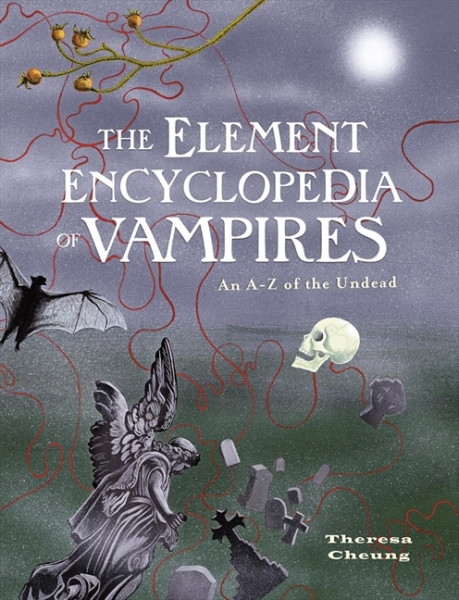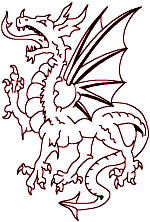All Saints Church, Nunnington and the Dragon of Loschy Wood
The following account of the legend of the Dragon of Loschy Hill was detailed in the 1888 book ‘Yorkshire Legends and Traditions’ by Rev Thomas Parkinson who quoted his source as being an article entitled Serpent Legends of Yorkshire from the Leisure Hour (May 1878).
In the church of Nunnington, in the North Riding of Yorkshire, is an ancient tomb, surmounted by the figure of a knight in armour, in a recumbent posture, the legs crossed, the feet resting against a dog, the hands apparently clasping a heart, but no inscription to determine to whom the monument belongs. The traditional account current in the neighbourhood is that it is the tomb of Peter Loschy, a famous warrior, whose last exploit was killing a huge serpent, or dragon, which infested the country, and had its den on a wooded eminence called Loschy Hill, near East Newton, in the parish of Stonegrave.
 The details of the combat, as related by tradition, are as follows:
The details of the combat, as related by tradition, are as follows:
Having determined to free the country from the pest, the redoubted Peter Loschy had a suit of armour prepared, every part of it being covered with razor-blades set with the edges outwards; and thus defended, armed only with his sword, and accompanied by a faithful dog, he went forth to seek the destroyer, which he quickly found in a thicket on Loschy Hill.
The dragon, glad of another victim, darted upon the armed man, notwithstanding a wound from his sword, and folded itself around his body, intending, no doubt, as it had often done before, to squeeze its victim to death, and afterwards to devour it at leisure; but in this it was disappointed. The razor-blades were keen, and pierced it in every part, and it quickly uncoiled itself again, when, to the great surprise of the knight, as soon as it rolled on the ground its wounds instantly healed, and it was strong and vigorous as ever; and a long and desperate fight ensued between the knight and the serpent, without much advantage to either. At length the sword of the knight severed a large portion of the serpent, which the dog quickly snatched up in his mouth, an ran across the valley with it nearly a mile, and there left it on a hill near Nunnington Church, and immediately returned to the scene of combat, and, snatching up another fragment, cut off in the same manner, conveyed it to the same place, and returned again and again for other fragments until they were all removed, the last portion conveyed being the poisonous head. The knight, now rejoicing at his victory, stooped to pat and praise his faithful dog; the latter, overjoyed, looked up and licked the knight’s face, when, sad to relate, the poison of the serpent imbibed by the dog was inhaled by the knight, and he fell down dead in the moment of victory, and the dog also died by the side of his master.
The villagers buried the body of the knight in Nunnington Church, and placed a monument over the grave, on which were carved the figures of the knight and his faithful dog, to witness to the truth of the story.
All Saints Church, Nunnington
This Grade I listed church dates 13th century though it has been renovated over time, with the tower dating from 1672 and the vestry from the late 19th century.
Within the church is the tomb of a knight which has been associated with the legend and hence identified with Peter Loschy. But the carving actually portrays a knight with a lion not a dog. The following description of the knight was taken from ‘A History of the County of York North Riding’ (1914):
In the south wall of the nave, within a recess with a multifoiled moulded ogee arch, flanked by gabled pilasters of one offset, is the effigy of a knight of the late 13th or early 14th century wearing a hauberk of mail, with camail, surcoat and knee-cops and holding his heart in his hands. A sword hangs by a belt; most of his shield has been broken away, but from what remains it appears to have borne the arms of Teye, lord of Stonegrave: (or) a fesse between two cheverons (gules) with three molets pierced (or) on the fesse. The feet rest upon a lion; the lion upon which the pillow supporting the head rested has nearly disappeared, one foot alone remaining. Another animal, portions of which remain, perhaps held the bottom of the shield in his teeth.
The carving actually represents Sir Walter de Teyes, Lord of Stonegrave Manor (born 1297). Walter served both King Edward I and King Edward II, who in 1309 made him joint Governor of York. Dying in 1325 he was buried in All Saints Church, Nunnington.




Re: All Saints Church, Nunnington and the Dragon of Loschy …
I don’t see this place Nunnington marked on the map in the "Featured sites" web page. But I am new to this website. Have I missed something? Is that map meant to show the location of all the stories in the website? (This is a question for the website makers, not a comment for that entry — the next para could be that.)
This legend is also in the book "Folk tales from the North York Moors" by Peter Walker. His version has a lot about one of the maidens taken by the "worm", making a fuller story. I do not know how much Walker adds himself — he is a good narrator but does not give sources.
Re: All Saints Church, Nunnington and the Dragon of Loschy …
Hi Timothy. All the articles relating to specific sites are listed in our gazetteer under country and county. The Featured Sites are a list of locations that may be of special interest.
I’ll look out for Peter Walker’s book 🙂